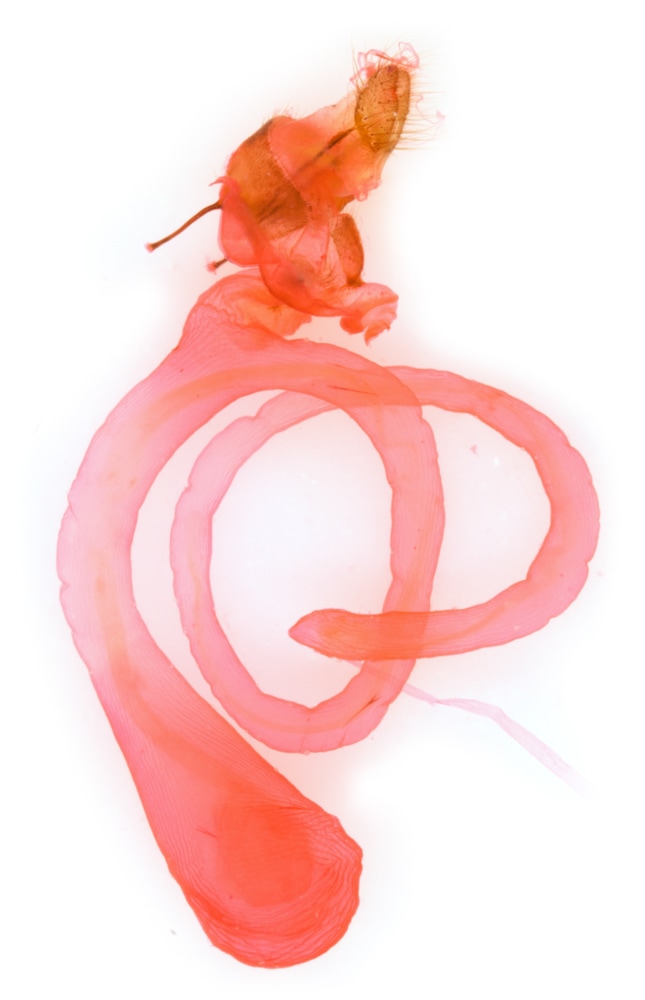Agrotis exclamationis (Heart & Dart) / A.segetum (Turnip moth) / A.clavis (Heart & Club) |
Typically, A.exclamationis has prominent black collar (patagia) a solid black dart mark and a plain forewing. A.segetum and A.clavis have less prominently marked patagia, a black-outlined dart mark and a more variegated forewing. A.segetum and A.clavis may be distinguished by hindwing colour - pearly white in male A.segetum, pearly light grey in female A.segetum and brownish-fuscous in both sexes of A.clavis.
All three species are variable in ground colour and some specimens are atypical.
Genital differences are described and illustrated below and are also covered by the Difficult Species Guide
All three species are variable in ground colour and some specimens are atypical.
Genital differences are described and illustrated below and are also covered by the Difficult Species Guide
Patagia - prominently marked with black in A.exclamationis
Male antenna - obviously bipectinate in A.segetum and A.clavis but not in A.exclamationis
Forewing - dart mark / variegation
A.exclamationis - solidly dark / fairly plain; A.segetum & A.clavis - (usually) dark outlined / (usually) moderately variegated
According to Waring & Townsend the forewing of A.clavis has a smaller length:breadth ratio than that of A.segetum or A.exclamationis, giving it a less elongate appearance and its dart mark is "usually shorter, blunter and more club-like". I have not found either of these distinctions helpful, and I am not convinced of their validity, as a means of separating these two species. From my dissected specimens A.exclamationis - length:breadth ratio = 2.37-2.54 (5 specimens); A.segetum - length:breadth ratio = 2.39-2.44 (3 specimens); A.clavis - length:breadth ratio = 2.24-2.56 (8 specimens); (there is some difficulty in determining exactly where the measurements should be made).
A.exclamationis - solidly dark / fairly plain; A.segetum & A.clavis - (usually) dark outlined / (usually) moderately variegated
According to Waring & Townsend the forewing of A.clavis has a smaller length:breadth ratio than that of A.segetum or A.exclamationis, giving it a less elongate appearance and its dart mark is "usually shorter, blunter and more club-like". I have not found either of these distinctions helpful, and I am not convinced of their validity, as a means of separating these two species. From my dissected specimens A.exclamationis - length:breadth ratio = 2.37-2.54 (5 specimens); A.segetum - length:breadth ratio = 2.39-2.44 (3 specimens); A.clavis - length:breadth ratio = 2.24-2.56 (8 specimens); (there is some difficulty in determining exactly where the measurements should be made).
Hindwing
Males: A.exclamationis - white; A.segetum - pearly white; A.clavis - light brownish fuscous.
Females: A.exclamationis - brownish fuscous; A.segetum - pearly light grey; A.clavis - brownish fuscous
Males: A.exclamationis - white; A.segetum - pearly white; A.clavis - light brownish fuscous.
Females: A.exclamationis - brownish fuscous; A.segetum - pearly light grey; A.clavis - brownish fuscous
Male genitalia: The 3 species are separated on features of the harpe. This is nearly straight in A.exclamationis; stout and tightly curved, hook-like in A.segetum; long and smoothly curved in A.clavis
Female genitalia: In A.segetum S8 has large rounded processes on either side of the ostium, which is not cupped, and the corpus bursae has a single linear signum. In A.clavis and A.exclamationis the rounded processes are absent, the ostium is cupped and there are no signa in the corpus bursae. These two differ in features of the appendix bursae which is shorter in A.clavis.






















